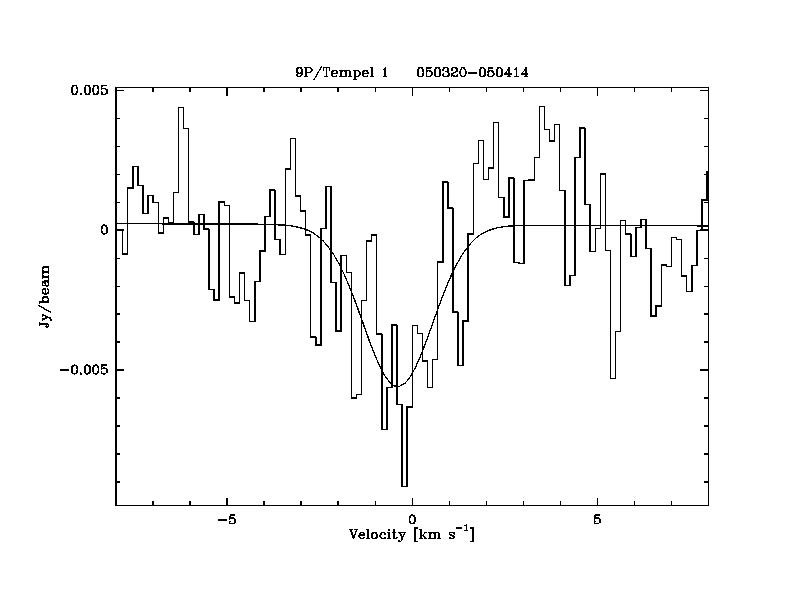
First detection (IAU Circ. No 8512): 9P/Tempel 1 (1667 MHz OH line) observed with the Nançay radio telescope. Average spectrum from 20 March to 14 April 2005. Average distances are 1.76 AU to the Sun, 0.79 AU to the Earth.
9P/Tempel 1 is the target of the Deep Impact mission (flyby and impact on 04 July 2005).
As part of the supporting observations to establish the activity level of this comet prior to the impact, observations of 9P/Tempel 1 were scheduled at the Nançay radio telescope from 4 March to 8 June. The goal was to observe the 18 cm lines of the OH radical, which traces cometary water.
The weak OH lines could be detected only after several days of integration (see IAU Circ. No 8512). From the average spectrum of 20 March to 14 April 2005, the signal (line area) was -12±2 mJy km/s, corresponding to an OH production rate of about 4 × 1027 molecules s-1, or a water production rate of about 5 × 1027 molecules s-1. This makes it the weakest comet ever detected with the Nançay radio telescope.
Observations were interrupted in June because the signal went below detection, due to the low inversion of the OH maser. They were resumed on 1 to 10 July to cover the impact event. However, no signal was detected presumably due to the low value expected for the OH maser inversion (< 0.1).
More details on the results of the monitoring are given in the table below.
__________________________________________________________________________________________________________________
date delta r rdot inv inv Tbg area S Vo dVo Q[OH]
AU AU km/s K mJy.km/s mJy km/s km/s E28s-1
__________________________________________________________________________________________________________________
050304-050319 0.98 1.89 -9.3 -0.23 -0.27 3.3 4 3 < 0.6
050320-050405 0.82 1.78 -8.6 -0.28 -0.33 3.3 -15 3 -4 1 -0.70 0.69 2.85 1.81 0.4 0.1
050406-050421 0.75 1.71 -7.8 -0.31 -0.37 3.3 -13 2 -8 1 -0.29 0.16 1.78 0.40 0.4 0.1
050422-050501 0.72 1.65 -6.9 -0.30 -0.36 3.2 -14 3 -12 2 -0.08 0.14 1.45 0.33 0.5 0.1
050502-050511 0.71 1.62 -6.1 -0.28 -0.34 3.2 -29 4 -14 2 -0.23 0.14 2.15 0.36 0.9 0.1
050512-050522 0.72 1.58 -5.2 -0.25 -0.30 3.2 -15 4 -9 2 0.13 0.20 1.90 0.47 0.6 0.2
050524-050602 0.75 1.55 -4.1 -0.21 -0.24 3.2 -16 4 -8 2 -0.62 0.24 1.78 0.60 0.8 0.2
050701-050710 0.90 1.51 0.1 0.03 0.08 3.3 11 4 < 3.7
__________________________________________________________________________________________________________________
The corresponding integrated spectra can be seen here
(jpeg version) and here
(ps version).The instrumentation, observation, reduction and analysis procedures are as described in
Crovisier et al. 2002, Astron. Astrophys., 393, 1053-1064
Crovisier et al. 2002, Asteroids Comets Meteors 2002, ESA SP-500, 685-688
The results of coordinated observations of other molecules with the IRAM 30-m radio telescope may be found here.
J. Crovisier, P. Colom, N. Biver, D. Bockelée-Morvan, A. Lecacheux
LESIA, Observatoire de Paris